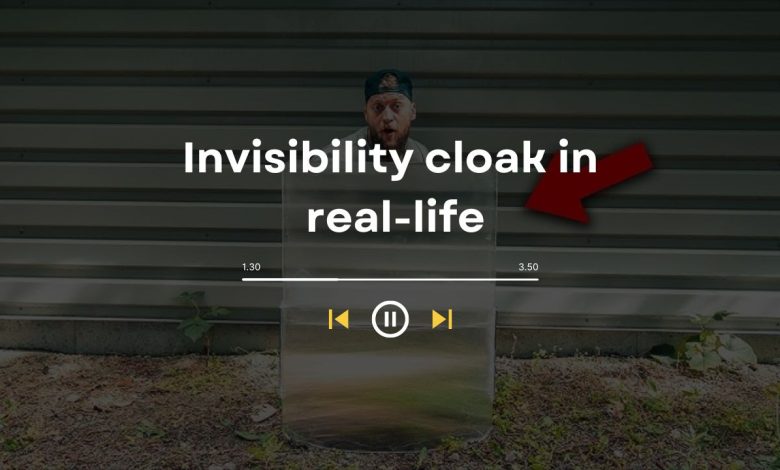
In a revolutionary development that blurs the lines between science fiction and reality, a remarkable technological marvel has been introduced to the world: the Invisibility cloak in real-life. This cutting-edge breakthrough, recently showcased by the innovative platform Nowviralvideo.com, represents a significant step forward in merging scientific advancements with imaginative concepts. Resembling the mythical cloak made famous in Harry Potter’s wizarding universe, this once-fictional garment has transcended the realms of fantasy to become a tangible reality, captivating the public’s imagination. This landmark unveiling not only introduces the real-life invisibility cloak but also signifies a substantial progression in the practical application of advanced technologies in our daily existence. Join us as we embark on this exploration, delving into the intricacies of this extraordinary revelation and examining its transformative potential for the future.
Contents
- I. The Realization of Invisibility Cloaks: Assessing Current State of Invisibility Cloak Technology
- II. Exploring the Historical Roots of Invisibility in Fiction
- III. Comparing Stealth Technology with Genuine Invisibility
- IV. Progress in Metamaterials and Metalenses for Invisibility Advancements
- V. Overcoming Challenges in Achieving Invisibility in the Visible-Light Spectrum
- VI. Metalenses as the Key to Achieving Visible-Light Invisibility
- VII. The Future Landscape: Invisibility cloak in real-life
I. The Realization of Invisibility Cloaks: Assessing Current State of Invisibility Cloak Technology
Advancements in nanotechnology have propelled the concept of an “Invisibility cloak in real-life” from fantasy into the realm of tangible possibility. Two key innovations, metalenses and metamaterials, stand at the forefront of this technological evolution.
The fusion of metalenses and metamaterials is driving groundbreaking developments in invisibility technology. Metalenses, known for their thin profile and versatility in focusing light across various wavelengths, play a crucial role in realizing a real-life invisibility cloak. Capable of manipulating incoming light waves, these lenses significantly contribute to the overall effectiveness of cloaking devices.
Simultaneously, metamaterials, a specialized multi-layered coating, have undergone substantial advancements over the past two decades. This metamaterial coating allows electromagnetic radiation, particularly specific wavelengths, to seamlessly bypass an object. In contrast to traditional transparency, where light penetrates through a material, metamaterials guide light around an object, making it virtually undetectable. The synergy between metalenses and metamaterials opens new dimensions in the pursuit of achieving true invisibility.
Once confined to the realms of fiction, the dream of a real-life invisibility cloak, reminiscent of Harry Potter’s iconic garment, is no longer merely a whimsical notion. Recent breakthroughs in nanotechnology, particularly the integration of metalenses and metamaterials, offer a glimpse into the potential realization of a universal invisibility cloak. This concept involves bending light of all wavelengths around an object, regardless of its shape, effectively “cloaking” it from view. This transformative possibility marks a significant step toward turning fantasy into reality.
The advent of Invisibility cloak in real-life immense promise for revolutionizing various technological applications. Beyond the allure of fantasy, the practical implications of such a breakthrough are far-reaching. From advancements in surveillance technology to military applications, the potential uses of invisibility technology are diverse and impactful. The ability to render objects unseen by bending light has the potential to redefine how we interact with our surroundings.
II. Exploring the Historical Roots of Invisibility in Fiction
The allure of an “Invisibility cloak in real-life” is deeply ingrained in the rich tapestry of human imagination, spanning literature, fantasy, myth, and science fiction. Stories throughout history have depicted beings and objects capable of disappearing from view, transcending the boundaries of the tangible world.
The yearning for invisibility has consistently featured in storytelling, mirroring humanity’s fascination with the unseen. Mythical creatures and fantastical entities have wielded the ability to vanish at will, underscoring the enduring allure of such a capability.
Invisibility gained widespread popularity with the rise of iconic franchises like Star Trek and Harry Potter. While Star Trek introduced the concept of a cloaking device, it was the enchanting world of Harry Potter that brought the idea of an “Invisibility cloak in real-life” into mainstream consciousness. These cultural phenomena propelled the concept beyond literary and cinematic realms, embedding it firmly in the collective imagination.
Despite the enduring fascination, practical applications of invisibility technology have faced limitations. Although stealth technology has made progress in specific wavelengths, achieving genuine invisibility, particularly in visible light, has remained a challenging endeavor. The journey from fictional portrayals to the emergence of the “Invisibility cloak in real-life” reflects an ongoing quest to narrow the gap between imaginative concepts and tangible scientific advancements.
III. Comparing Stealth Technology with Genuine Invisibility
Advancements in stealth technology, while impressive, underscore the disparity between traditional camouflage methods and the elusive concept of an invisibility cloak in real-life.
The strides made in stealth technology have been particularly notable in diminishing the detectability of objects, primarily within the microwave-to-radio wavelength range. Drawing inspiration from nature’s camouflage mechanisms, this technology aims to reduce an object’s radar cross-section, making it less susceptible to detection.
Nevertheless, the limitations of stealth technology become evident when aiming for true invisibility, especially in the visible light spectrum. Achieving effective camouflage across the entire range perceivable by the human eye poses a complex challenge, leading to the exploration of alternative technologies such as metamaterials and metalenses.
While stealth technology excels in the microwave-to-radio wavelength range, the pursuit of real-life invisibility cloaks revolves around manipulating visible light, presenting a novel frontier in the quest for comprehensive and genuine invisibility.
IV. Progress in Metamaterials and Metalenses for Invisibility Advancements
Advancements in metamaterials and metalenses have played a pivotal role in propelling the evolution of invisibility technology, marking a transformative phase in the realization of a genuine “Invisibility cloak in real-life.”
At the core of contemporary invisibility research are metamaterials, intricate multi-layered coatings that enable the manipulation of electromagnetic radiation, surpassing the capabilities of conventional materials. These materials guide light around objects, holding the promise of achieving true invisibility by redirecting light from all angles.
A significant breakthrough occurred in 2018 with the introduction of broadband achromatic metalenses, representing a substantial leap forward in rendering objects undetectable across the entire visible light spectrum. The combination of metamaterials and metalenses in this breakthrough hinted at the potential attainment of visible-light invisibility.
Critical to the success of metalenses is the utilization of nanofins, specifically designed to guide light through different sections of the material. This nanofin technology allows for precise bending of light at various wavelengths, a crucial element in the development of a versatile and efficient real-life invisibility cloak. The collaborative synergy between metamaterials and nanofin-equipped metalenses opens new frontiers in bending light across a spectrum of wavelengths, offering optimal invisibility possibilities.

V. Overcoming Challenges in Achieving Invisibility in the Visible-Light Spectrum
Embarking on the journey to achieve real-world visibility in the realm of visible light poses numerous challenges, highlighting the intricacies involved in bringing the concept of an “Invisibility cloak in real-life” to fruition.
The primary hurdle revolves around grappling with the inherent behaviors of materials when exposed to light. Conventional materials tend to either absorb or reflect light, posing a significant impediment to the pursuit of transparency. The key to attaining true invisibility lies in surmounting these obstacles, ensuring that light can effortlessly traverse through materials without obstruction.
The complexity deepens when attempting to devise a cloaking device capable of rendering inherently non-transparent materials invisible. Such technology must transcend mere camouflage, presenting a holistic solution that conceals objects of varying shapes and sizes.
Achieving genuine invisibility requires the adept manipulation of light across a broad spectrum of wavelengths. Successful technology must adapt to the nuances of visible light, bending it effectively and consistently. Conquering these challenges stands as a pivotal step toward realizing a bona fide visible-light invisibility cloak, ushering in a transformative shift in how we perceive the world.
VI. Metalenses as the Key to Achieving Visible-Light Invisibility
Harnessing the potential of visible-light invisibility relies on the cutting-edge capabilities of metalenses, marking a pivotal advancement in the quest for a Invisibility cloak in real-life.
Metalenses, distinguished by their unique features, represent a groundbreaking departure from conventional lenses. Their extraordinary thinness, often just fractions of a wavelength, provides a distinctive advantage. Crafted to manipulate incoming light waves, these lenses introduce a transformative approach to achieving visibility control beyond the capacities of typical optical devices.
An essential aspect of metalenses lies in the incorporation of nanofins, enabling precise tuning of the speed of light. This functionality allows the concentration of light waves across diverse wavelengths, particularly in the visible spectrum. Nanofins act as conductors, directing light with unparalleled precision to achieve optimal invisibility.
Metalenses not only showcase exceptional performance but also redefine design parameters. Their inherent thinness and streamlined use of nanofins contribute significantly to reducing both thickness and design complexity. This progress opens doors to more accessible, practical, and efficient applications of visible-light invisibility technology, representing a substantial stride towards realizing this remarkable scientific feat.
VII. The Future Landscape: Invisibility cloak in real-life
The advancement of metalenses goes beyond mere fascination, holding the potential for various applications, both marketable and transformative, paving the way for the eventual realization of the “Invisibility Cloak in Real Life.”
Metalenses, characterized by their thin profile and ability to focus light across different wavelengths, present immediate marketable applications. These lenses are positioned to revolutionize devices such as cameras, virtual reality (VR) devices, microscopes, and other optical technologies, enhancing performance by providing clearer imaging and compact designs for everyday use.
Looking forward, the overarching vision involves a synergistic fusion of metalenses with metamaterials, creating a harmonious blend that drives the development of authentic invisibility cloaks. This fusion tackles current challenges by combining the strengths of both technologies to create a comprehensive solution for achieving visible-light invisibility.
The journey towards the realization of the “Invisibility Cloak in Real Life” requires overcoming intricate challenges. The integration of metalenses and metamaterials offers a robust solution, holding the potential to surpass current limitations and usher in a new era of unseen possibilities. This collaborative effort in technological advancement marks a crucial step toward turning science fiction into a tangible reality.
>>> See more: Arlington VA House Explosion Video: Timeline of the Incident


![[FULL] Watch Logan Paul Wife Video On Reddit 5 [FULL] Watch Logan Paul Wife Video On Reddit](https://nowviralvideo.com/wp-content/uploads/2023/09/logan-paul-wife-video-390x220.jpg)
![[HOT] Watch Anshu Malik Viral Video Mms 6 [HOT] Watch Anshu Malik Viral Video Mms](https://nowviralvideo.com/wp-content/uploads/2023/09/anshu-malik-viral-video-mms-390x220.jpg)